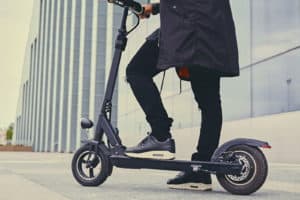As electric scooters have become a fast-growing trend, there are a few quirks that a number of people have run into with growing pains to this new mode of transportation. There are, however, good words of wisdom to go by. Consider these smart traveling plans if you’re interested in traveling with your electric scooter.
Short Distance Trips
 Most electric scooters are designed for short distance commutes and are particularly handy in urban travel. Depending on the scooter’s make, engine size, and battery life, an electric scooter can travel anywhere between 25 and 45 miles with speed 5 to 35 miles per hour. If you’re planning to purchase a scooter, consider what features the scooter has that will best fit the type of needs you have in your lifestyle. Some scooters are designed for portability but offer shorter distance while others are sturdier like gas-powered motorcycles but slower.
Most electric scooters are designed for short distance commutes and are particularly handy in urban travel. Depending on the scooter’s make, engine size, and battery life, an electric scooter can travel anywhere between 25 and 45 miles with speed 5 to 35 miles per hour. If you’re planning to purchase a scooter, consider what features the scooter has that will best fit the type of needs you have in your lifestyle. Some scooters are designed for portability but offer shorter distance while others are sturdier like gas-powered motorcycles but slower.
Prolonging the lifespan of your scooter largely depends on how you handle charging the battery. Be sure to follow manufacturer instructions regarding the details for battery maintenance. While scooter care can vary depending on the specific model, it is generally good practice to charge the scooter battery after each ride to keep the chemicals active. Be careful not to overcharge the battery though, since this can cause greater harm than good. Overcharging the battery may cause it to swell, greatly shorten the scooter’s traveling distance, and even render the scooter itself useless. If the scooter sustains an acidic odor when you’re standing near it, then the battery and perhaps the scooter itself needs replacement. Using the manufacturer’s recommended charge time as a guide is a good way to figure out your scooter’s threshold time for charging. Remember that it is better to undercharge than overcharge.
Long Distance Trips
 The same rules of thumb for traveling with your electric scooter’s battery life also apply if you’re planning to use it for long distance road trips. If it is not possible to charge the battery in the places you are staying, take the time to familiarize yourself with key charge spots that are near you, are neat and tidy, and safely out of the way from pedestrian traffic. Cafes and coffee shops are good examples since it usually takes a couple hours of average charge time.
The same rules of thumb for traveling with your electric scooter’s battery life also apply if you’re planning to use it for long distance road trips. If it is not possible to charge the battery in the places you are staying, take the time to familiarize yourself with key charge spots that are near you, are neat and tidy, and safely out of the way from pedestrian traffic. Cafes and coffee shops are good examples since it usually takes a couple hours of average charge time.
If you’re tempted to bring your electric scooter with you to other modes of transportation besides a car, always check with the traveling company’s regulations prior to booking. Unless disability assistance or special requests apply, airlines do not allow electric scooters to be boarded on planes because of the 100 watt hour lithium battery limitations in FAA regulations. It is possible, however, for electric scooters to be boarded on buses and trains if they are 30 pounds or lighter and foldable. Cruise ships also accept scooters according to each company’s regulations, especially those designed for special needs. Some even offer electric scooter rental services to travel inside the cruise ships. If you’re traveling overseas, be sure to read up on what kind of electric charge outlets are available, as different plug sizes and wattage measurements can vary from country to country. If electric wattage flow appears to be sketchy at your destination, consider leaving the scooter behind as a precaution – better to be safe than sorry. But if there’s a good chance you can bring the scooter along with the right adapters, go right ahead and enjoy your freedom!
Conclusion
While it can be tricky to navigate with your electric scooter, it’s not a difficult task with the right research. By planning smart, being prudent, and following your manufacturer’s recommendations, you’re well on your way to enjoy the road in modern style.
Related posts:
